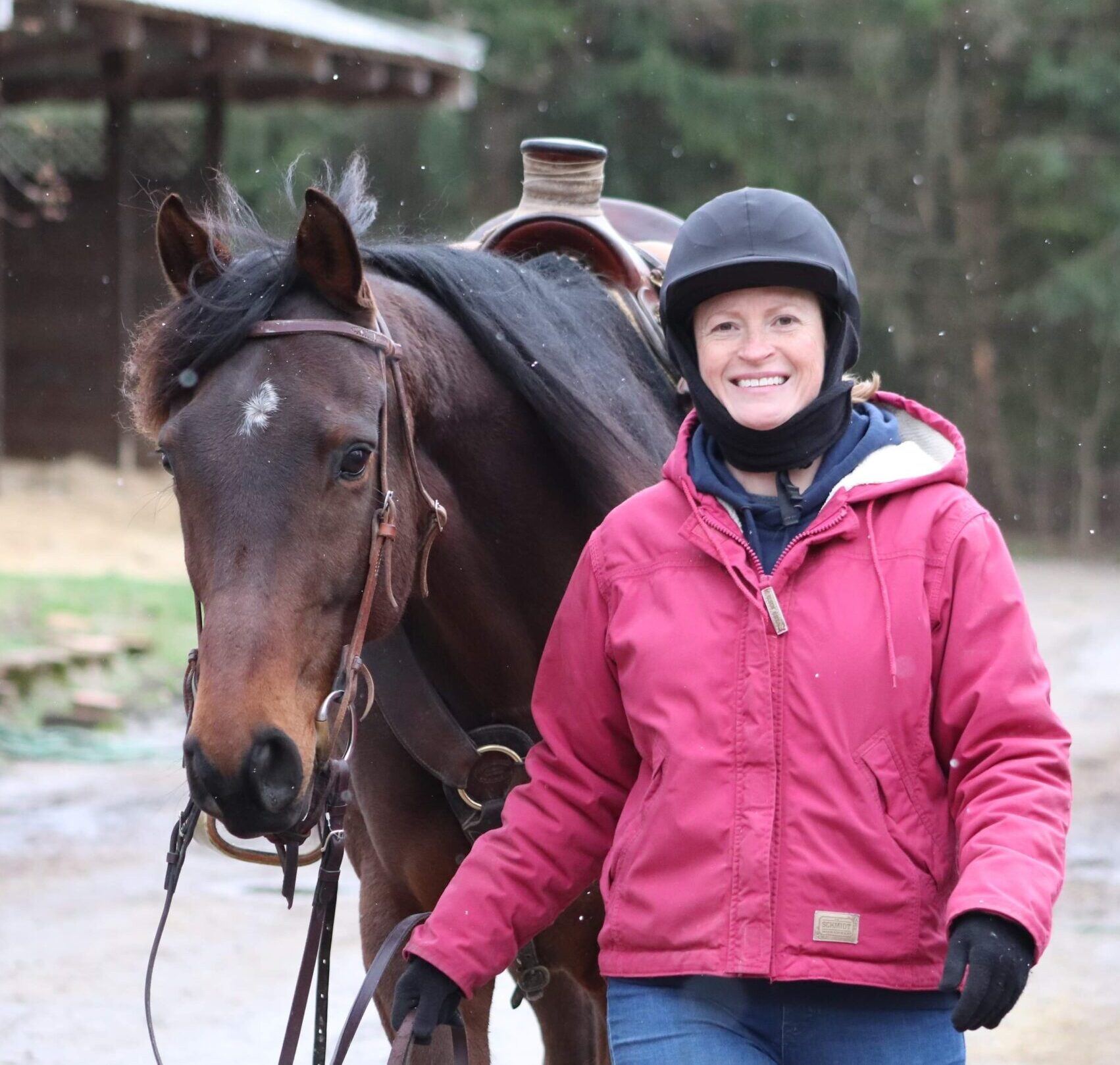Friends of Ferdinand
All Posts & News Press Releases Success Stories Aftercare Editorials Retraining Tips Supporter Features Inspector Spotlights Previous Post How to Teach Your Retired Racehorse to Jump How to Teach Your Retired Racehorse to Jump By: Alexis Arbaugh June 6, 2024 Retraining Tags:Friends of Ferdinand, hunter jumper, hunters, jumper, jumpers, Jumping, Retraining Tips, show jumping Alien Invasion – Photo provided by Lori Miller Lori Miller, Friends of Ferdinand Many people who adopt a Thoroughbred after it is retired from racing hope to train their horse for a second career, often in disciplines that involve jumping. Training a Thoroughbred to jump can be a brand-new experience for these retired athletes, as racehorses—unless experienced in steeplechase—don’t engage in jumping or even handling poles. Their primary focus is running on the flat and being trained for speed. Therefore, it can be challenging to teach an off-the-track Thoroughbred how to carefully and skillfully navigate a course of jumps. Lori Miller is the head trainer at Friends of Ferdinand, an organization accredited by Thoroughbred Aftercare Alliance. Located in Indianapolis, Indiana, Friends of Ferdinand specializes in retraining, rehabilitation, adoption, and providing sanctuary homes for Thoroughbreds retired from racing. Lori has extensive experience with racetracks and retired racehorses and takes pleasure in the retraining process, knowing that racehorses can have happy and healthy lives in new careers. Lori’s wealth of experience and knowledge makes her the perfect person to help fellow adopters navigate their new horse’s retraining process. It is difficult to determine if a horse will be a good jumper just by looking at them, as there are many factors to consider and different contexts for evaluation. “If you are at the track, it’s tough. A horse that races in blinkers or wears a shadow roll might be one that has a lot to think about,” Lori wrote. Horses that need to wear blinkers to focus generally have excess energy and are spooky. Lori generally tries to avoid spooky horses because it creates more problems when teaching them to jump. “I prefer the horses that will walk with confidence through whatever,” Lori wrote. Lori also considers conformation when assessing whether a horse would be good at jumping. She likes horses that seem to float when they travel, rather than stomp. She avoids horses with crooked legs, tiny feet, or a downhill build. Instead, she looks for horses that are balanced with an uphill build and correct angles. She prefers straight legs that allow the horse to stand under themselves and a neck that ties in high to their shoulders. Although there are outliers—horses with unconventional conformation that make wonderful jumpers—they are few and far between. A horse with a good attitude is always easier to work with than one that is grumpy or has a poor attitude. When asked about the kind of attitude or temperament she looks for, Lori replied that she seeks “the horse that wants to work with you, the horse that looks to the person rather than away”. A horse that wants to learn and seeks guidance from people is always going to excel. However, it is easier to evaluate a horse’s willingness after they have had a chance to settle down on a farm following their racing career. It usually takes some time after leaving the track for a horse to come out of its shell and show its true personality. “How they are at the track is frequently very different than they are away from home,” Lori wrote. Any horse that is friendly and easy to work with and around is a good start. “I want the horse to learn to go over what is put in front of it. Systematically by never asking it to do something we haven’t built up to. Teaching the horse to stay in a rhythm and not run, that there is no reason to get tight and anxious. I want my horses to learn it’s all positive”. Lori Miller Friends of Ferdinand So, now that you have your horse, how do you start jumping? Lori begins with basic flat work to ensure the horse is supple and responsive to the bit. She encourages the horse to move forward off the leg and be quick and accurate with transitions, ensuring the horse is always listening. After establishing a strong flat foundation, she introduces poles on the ground, having the horse casually walk, trot, and canter over them until they are no longer an issue. She wants the horse to get used to riding around standards, poles, and jumps in the arena, encouraging them to watch and continue working. When Lori feels the horse is ready to jump, she starts with a small jump that the horse can easily walk over. If the horse stops in front of the jump, she breaks it down to make it more inviting. “Slow work to build a confident horse,” Lori wrote. By this point, the horse is accustomed to going over poles and small boxes, so a small cross rail shouldn’t be a big deal. Their first actual jump might be a cross rail or a small log in the field, and the horse shouldn’t be fazed by it. Desensitizing your horse to various obstacles helps prevent stress or nervousness about jumping. When asked what Lori would like the horse to take away from their first jumping experience, she replied, “I want the horse to learn to go over what is put in front of it. Systematically by never asking it to do something we haven’t built up to. Teaching the horse to stay in a rhythm and not run, that there is no reason to get tight and anxious. I want my horses to learn it’s all positive”. Lori often trots over fences in the beginning stages of teaching a horse to jump. This allows the horse to learn to make a shape and stay straight while building confidence at a slower and more balanced pace. She advises against over-jumping young horses or those learning to jump, limiting
Read More >After 12 starts in the States, the son of Flower Alley ran an additional 23 races at Camarero Race Track in Puerto Rico. In 2020, “Vinny” was able to return home to the mainland with the help of TAA-accredited Caribbean Thoroughbred Aftercare and the willingness of TAA-accredited aftercare charities in the U.S. to take in these horses upon their return.
Read More >The Thoroughbred Aftercare Alliance (TAA) hosted its Second Annual Calendar Photo Contest. Twelve winning photos were chosen to be featured in the 2023 TAA calendar. Entries for the contest were collected online from April 5 until June 11, 2022. Contestants had the opportunity to win the top prize of a Tipperary 9800 Devon with MIPS helmet, sponsored by Tipperary. The top 12 winners received a TAA swag bag and copy of the 2023 calendar. The first-place submission, which is also featured on the cover of the 2023 TAA Calendar, was won by Erin Degnan and her adopted off-track Thoroughbred Cackle the Cuda, courtesy of John Miller, Spectrum Photography. Cackle the Cuda made 43 starts before retiring from racing with a record of 8-11-6 and earnings of $118,790. Now this Kentucky-bred warhorse is enjoying a life of competitive trail and endurance riding. TAA-accredited After the Races began retraining Cackle the Cuda for a second career after racing, before placing him for adoption which ultimately led the son of Candy Ride (ARG) to Degnan. The 12 photographs chosen for the 2023 calendar photo contest are as follows: “Caribbean Meets Cowboy” by Chelsey Burris – TAA-accredited Organization: Friends of Ferdinand “Cackle the Cuda” by Erin Degnan (Photo by: John Miller of Spectrum Photography) – TAA-accredited Organization: After the Races “Hard Work Working Hard” by Natalie DePinto (Photo by: AK Dragoo Photography) – TAA-accredited Organization: Thoroughbred Placement Resources “Cyrus Looks to The Future” by Robin Doniger – TAA-accredited Organization: Equine Rescue and Adoption Foundation “Just A Girl and Her Heart Horse” by Lyndsy McLendon – TAA-accredited Organization: Equine Rescue of Aiken “Three Bears” by Anita Motion – TAA-accredited Organization: Thoroughbred Retirement Foundation “Peekaboo, I see you!” by Sarah Mowat – TAA-accredited Organization: Illinois Equine Humane Center “Learning Something New” by Natasha Roberson – TAA-accredited Organization: Caribbean Thoroughbred Aftercare “Let’s Rumble” by Courtney VanErstvelde (Photo by: Jessika Lester Photography) – TAA-accredited Organization: After the Races “Winter Walks” by Justine Watson (Photo by: Glenn Watson) – TAA-accredited Organization: After the Races “Playing in the Pond” by CJ Wilson (Photo by: Philip Martin) – TAA-accredited Organization: Win Place Home “Splish Splash” by Wendy Wooley – TAA-accredited Organization: Secretariat Center For the second consecutive year, the TAA calendar is sponsored by Repole Stable. “The TAA is an awesome organization that we are always thrilled to support,” said Mike Repole. “Their calendar is a great way to show off what our amazing Thoroughbreds can do off the track.” “Congratulations to all our Photo Contest winners, and thank you to everyone who entered,” said TAA Office Manager, Catherine Flowers. “We received many wonderful photos of Thoroughbreds excelling in their second careers, and we look forward to sharing these photos and stories with TAA supporters and donors. Thank you also to our generous sponsors Tipperary and Repole Stable for enabling us to put on this fun contest and produce this beautiful calendar for the second year.” The 2023 TAA Calendar is now available for pre-order. Every $20 donation to the TAA is eligible to receive a calendar upon request. Calendars will begin shipping in November. To preorder the 2023 TAA Calendar, click here.
Read More >Indygo Joe only made one start before retiring to TAA-accredited Friends of Ferdinand. Although the son of Indygo Shiner wasn’t meant for the fast lane, he has since found his place.
Read More >Initially looking for an experienced Quarter Horse, adopter Kelly Meng fell in love with a chestnut Thoroughbred mare at Friends of Ferdinand. Now, this “Penny” is beginning to shine.
Read More >The New Vocations All-Thoroughbred Charity Show and Thoroughbred Incentive Program Championships held Sept. 6-8, 2019 at the Kentucky Horse Park was a success for TAA grads. TAA-accredited organizations were well represented in numerous disciplines and their horses shined bright competitive classes. The TAA presented High Point awards in four disciplines: dressage, hunter, jumper, and pleasure. Dressage: Little Latin Lulu and Kara Hertz Hertz adopted Little Latin Lulu from the Maker’s Mark Secretariat Center in May of 2019. The duo earned first place in both the Intro test A adult amateur and Intro test B adult amateur with scores of 70% and 68%. There were 10 horses from four TAA-accredited organizations competing for the TAA Dressage High Point Award. Hunter: Big City Dancer and Sue Sylvester Sylvester adopted Big City Dancer from the Maker’s Mark Secretariat Center in 2012. There were 22 horses from nine TAA-accredited organizations competing for the TAA Hunter High Point Award. Jumper: Kulik Lodge and Taylor Wienold Brooke Schafer adopted Kulik Lodge from the New Vocations Racehorse Adoption Program in October of 2016. There were four horses from three TAA-accredited organizations competing for the TAA Jumper High Point Award. Pleasure: Frank’s Gift and Victoria Kupets Kupets adopted Frank’s Gift from the New Vocations Racehorse Adoption Program in May of 2019. There were four horses from two TAA-accredited organizations competing for the TAA Pleasure High Point Award. In total, 12 TAA-accredited organizations were present at the New Vocations All-Thoroughbred Charity Show and TIP Championships. After the Races Akindale Thoroughbred Rescue Friends of Ferdinand Kentucky Equine Adoption Center Maker’s Mark Secretariat Center MidAtlantic Horse Rescue Inc New Vocations Racehorse Adoption Program Old Friends ReRun, Inc Second Stride, Inc Thoroughbred Retirement Foundation Thoroughbred Retirement Network of Louisiana Congratulations to all of our TAA grads on their success in second careers! Photo: Melissa Bauer-Herzog / Pyrois Media Click here to learn more or sign up for the Thoroughbred Incentive Program.
Read More >



















